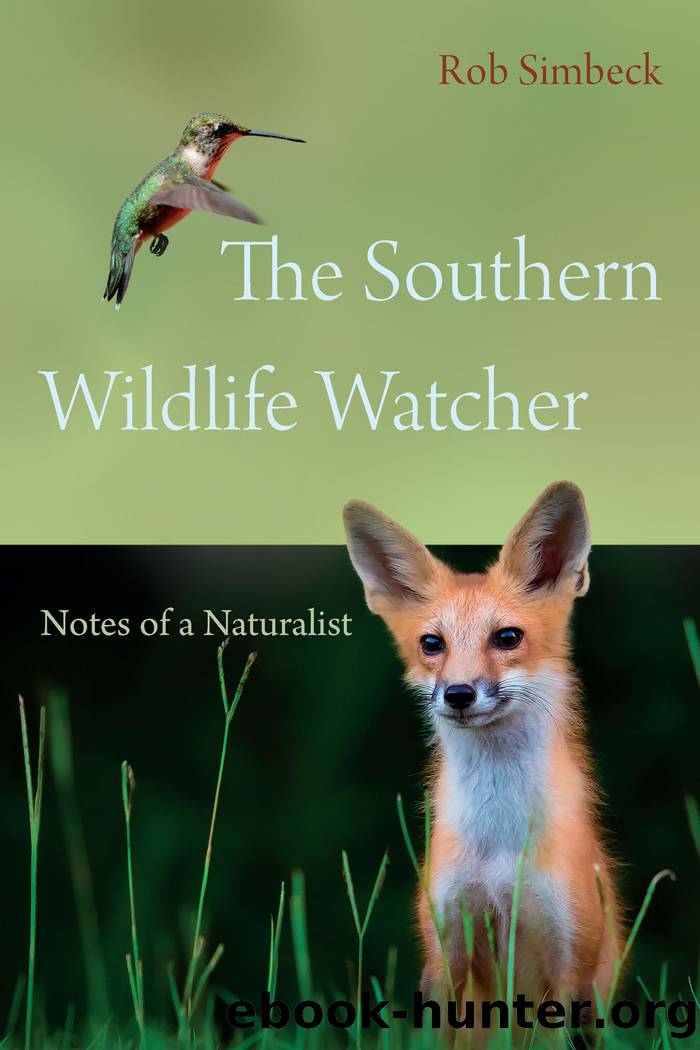The Southern Wildlife Watcher by Rob Simbeck;

Author:Rob Simbeck;
Language: eng
Format: epub
Publisher: University of South Carolina Press
Published: 2020-10-15T00:00:00+00:00
Bobcat
We need look no further than fairy tales to grasp the enmity Europeans had for predators. Wolves took the brunt of it, since lions, which once roamed widely across southern Europe, had for the most part disappeared by the first century ad. (Bears were extinct in England and in retreat elsewhere in Europe by the same time.) Classic fairy tales, such as The Three Little Pigs and Little Red Riding Hood, with their roots in the oral traditions of early European societies, and the Greek fable The Little Boy Who Cried Wolf all attest to the wolfâs sway on the early human imagination.
When European settlers arrived in the New World, the vast North American continent was as rich with predators as it was with other flora and fauna. The larger ones often took livestock, and settlers began hunting, trapping, poisoning, and otherwise working to eradicate them. It took centuries, but the eastern mountain lion was declared extinct in the wild in 2013. A subspecies, the Florida panther, which once roamed from Arkansas to the Carolinas, is represented by perhaps two hundred individuals in southern Florida. The red wolf was declared extinct in the wild in 1980 (a nonessential experimental population of a few dozen roams a small portion of eastern North Carolina now).
But one of the smaller predators native to the Southeast, the bobcat, has used its inborn stealth and wariness to survive into the twenty-first century, though it has not been easy.
âLike most predators that competed with man for food, bobcats were killed with near impunity due to their potential as predators of game and livestock,â says Jay Butfiloski, supervisor for the South Carolina Department of Natural Resourcesâ Furbearer Project, âprobably up through the time that the region really began to transition away from being primarily an agrarian society.â
It is estimated, though, that there are now between 2.3 and 3.6 million bobcats throughout its range. A decline in the popularity of hunting bobcats is no doubt one factor. Regulated hunting is thought to account for about half of bobcat deaths annually, with automobiles contributing as well. There is a legal trade in bobcat skins, and in 2015 more than sixty-five thousand were exported. Bobcats are also susceptible to diseases, including scabies, and to poisoning by way of eating poisoned rats or mice. As with many creatures, habitat loss and fragmentation are major concerns.
Download
This site does not store any files on its server. We only index and link to content provided by other sites. Please contact the content providers to delete copyright contents if any and email us, we'll remove relevant links or contents immediately.
The Lonely City by Olivia Laing(4569)
Animal Frequency by Melissa Alvarez(4150)
All Creatures Great and Small by James Herriot(3986)
Walking by Henry David Thoreau(3681)
Exit West by Mohsin Hamid(3634)
Origin Story: A Big History of Everything by David Christian(3472)
COSMOS by Carl Sagan(3348)
How to Read Water: Clues and Patterns from Puddles to the Sea (Natural Navigation) by Tristan Gooley(3240)
Hedgerow by John Wright(3106)
How to Do Nothing by Jenny Odell(3102)
The Inner Life of Animals by Peter Wohlleben(3099)
How to Read Nature by Tristan Gooley(3079)
Project Animal Farm: An Accidental Journey into the Secret World of Farming and the Truth About Our Food by Sonia Faruqi(3018)
Origin Story by David Christian(2992)
Water by Ian Miller(2953)
A Forest Journey by John Perlin(2916)
The Plant Messiah by Carlos Magdalena(2747)
A Wilder Time by William E. Glassley(2690)
Forests: A Very Short Introduction by Jaboury Ghazoul(2671)
